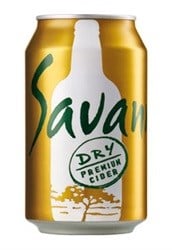The beverage market in South Africa is experiencing a dramatic period of change as consumer drinking habits are moving more and more towards a can preference. Despite holding a relatively small share of the total beverage package market, factors such as innovation, new introductions and significant promotional activity are driving the ever-increasing demand for aluminium beverage cans.
A growing variety of brands, such as Energade, Game and Savanna, has recently become available in cans and contributed to the current can demand in the market. Savanna's move to aluminium cans after many years of only being available in glass clearly emphasises this shift in consumer demand.
"Business needs to invest in good infrastructure, equipment and the skill level of their employees if they want to be sustainable and competitive in their efforts to meet the needs of the growing market and consumer demands," said Klaus Hass, Marketing Director of Nampak Bevcan. Successfully managing these factors is the key to dealing with the current growth of canned beverage packaging.
Drinking preferences are changing
Last month, Roy Campbell, a partner of Deloitte & Touche and speaker at the Packaging and Beyond Africa Conference explained that drinking preferences in Africa are changing as the majority of the continent's population comprises young people whose tastes differ from the older generation's, it is no surprise that Africa is experiencing a rapid growth within the newer beverage categories of still, energy, sports and iced tea drinks. *
Based on the latest independent BMI Research, more and more South Africans are choosing cans, and, more specifically, the 440ml beverage can packaging. According to the insights provided by BMI Research (below), the 440ml beverage cans have seen the greatest growth from 2013 to 2014.
South Africans went from consuming a total of 385,060,000 440ml beer cans to 625,741,000 in 2014; a significant increase of 62.5%. Canned soft drinks (CSD) experienced an increase from 94,156,000 to 178,336,000; 440ml energy drink consumption climbed from 89,444,000 in 2013 to 123,118,000 in 2014 and 100 million more units of the 440ml ciders were consumed within a year, 59,679,000 to 159,625,000.
| Pack | Category | Units 2013 | Units 2014 | | 440ml | Beer | 385,060,000 | 625,741,000 |
| 440ml | CSD | 94,156,000 | 178,336,000 |
| 440ml | Energy | 89,444,000 | 123,118,000 |
| 440ml | Cider | 59,679,000 | 159,625,000 |
| Total | | 628,339,000 | 1,086,820,000 |
The numerous benefits of aluminium beverage packaging are also a contributing factor for its ever-increasing demand within the beverage packaging industry. The Australian Aluminium Association emphasises that aluminium beverage and food packaging cans provide numerous preservation advantages as they do not rust, are resistant to corrosion and provide one of the longest shelf lives of any type of packaging. The association explains that the safety record of aluminium cans, a tamper-resistant and tamper-evident source of packaging, provides consumers with peace of mind that their products have been safely prepared and delivered. **
In addition, Hass explained that beverage packaging markets are evolving and that access to the market, information, education, telecommunications and mobile social platforms are all contributors to the current change in beverage consumption patterns. The affordability of aluminium beverage packaging, as well as the disposable income of consumers, also affects the specific product and packaging demand.
"The beverage packing demand within South Africa differs significantly when compared to markets within Europe or the US. A unique challenge that needs to be dealt with is incorporating all the various cultural, social and taste profiles of the country's diverse consumer market," Hass elaborated.
Accessing and maintaining a competitive presence within the African market remains difficult as companies face significant barriers to new territories due to high barriers and cost of entry, as well as bureaucratic and regulatory requirements.
For more information about Nampak Bevcan, go to www.nampak.com/Metals-Bevcan.aspx or contact +27 (0) 11 519 7711.
Sources:
* Letsebe, K.M. 2015. The future of packaging in Africa. [Accessed: 2015-07-19]
** Packaging Reporter, June 2015 edition, page 4-5































